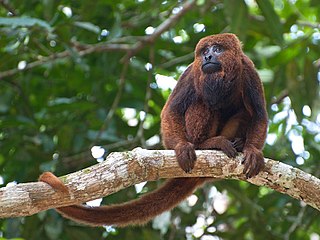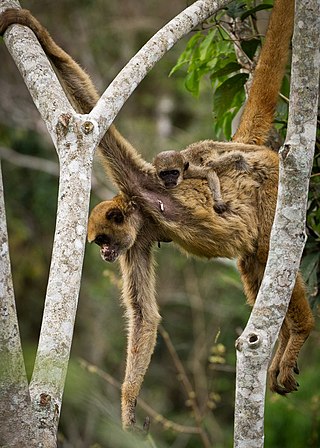
The Colombian red howler or Venezuelan red howler is a South American species of howler monkey, a type of New World monkey, found in the western Amazon Basin in Venezuela, Colombia, Ecuador, Peru and Brazil. The population in the Santa Cruz Department in Bolivia was split off as a separate species, the Bolivian red howler, in 1986, and more recently, splitting off the population in northeastern South America and Trinidad as the Guyanan red howler has occurred. All howler monkeys belong to the family Atelidae and the infraorder Platyrrhini.

The brown howler, also known as brown howler monkey, is a species of howler monkey, a type of New World monkey that lives in forests in southeastern Brazil and far northeastern Argentina (Misiones). It lives in groups of two to 11 individuals. Despite the name "brown howler", it is notably variable in colour, with some individuals appearing largely reddish-orange or black.

The black howler or black-and-gold howler, is among the largest New World monkeys and a member of the Alouatta genus. The black howler is distributed in areas of South America such as Paraguay, southern Brazil, eastern Bolivia, northern Argentina, and Uruguay. This species is sexually dimorphic, with adult males having entirely black fur and adult females and babies of both sexes having an overall golden colouring; which emphasizes black-and-gold in the name. The IUCN Red List has classed the black howler as Near Threatened as a result of a recent population reduction due to a variety of human-caused factors.

The red-handed howler is a vulnerable species of howler monkey, a type of New World monkey. It is endemic to Brazil, found in the southeastern Amazon and disjunctly in the Atlantic Forest between Rio Grande do Norte and Sergipe.

The Bolivian red howler is a species of howler monkey, a type of New World monkey, endemic to Bolivia. It can be found in rain forests, including riverine and seasonally flooded forests.

The mantled howler is a species of howler monkey, a type of New World monkey, from Central and South America. It is one of the monkey species most often seen and heard in the wild in Central America. It takes its "mantled" name from the long guard hairs on its sides.

The Yucatán black howler, or Guatemalan black howler, is a species of howler monkey, a type of New World monkey, from Central America. It is found in Belize, Guatemala and Mexico, in and near the Yucatán Peninsula. It lives in evergreen, semideciduous and lowland rain forests. It is also known as the baboon in Belize, although it is not closely related to the baboons in Africa.

The northern muriqui is one of two species of muriqui. They are also known as woolly spider monkey because they exhibit the woollen pelt of woolly monkeys and the long prehensile tail of spider monkeys. Muriquis are the largest extant New World monkeys. They can reach 4.3 feet or 1.3 metres long and weight up to 7 to 10 kilograms. The northern muriqui is a critically endangered species, it is estimated that there are less than 1000 mature individuals in the wild. The species is unusual among primates in that they display egalitarian tendencies in their social relationships. This species is endemic to the Atlantic Forest region of Brazilian states of Rio de Janeiro, Espírito Santo, Minas Gerais and Bahia. Their diets, travel patterns and reproductive cycles are seasonally determined. The size of each group can fluctuate as females will move between groups of monkeys.

The Guyanan red howler is a species of howler monkey, a type of New World monkey, native to Suriname, Guyana, Trinidad, French Guiana, Venezuela and Brazil.
The Azuero howler a type of monkey that is a subspecies of the Coiba Island howler A. coibensis. This subspecies is endemic to the Azuero Peninsula in Panama. The Azuero howler is distinguished primarily by its golden flanks and loins, and browner appearance on the rest of its body.

The golden-mantled howler is a subspecies of the mantled howler, A. palliata. It ranges throughout much of Central America, in Guatemala, Honduras, Nicaragua and Costa Rica, and possibly Panama. The range limits between the golden-mantled howler and the Ecuadorian mantled howler are not entirely clear. The Ecuadorian mantled howler replaces the golden-mantled howler in either extreme eastern Costa Rica or western Panama.

The Mexican howler is a subspecies of the mantled howler, A. palliata. This subspecies is found predominantly in forests between south eastern Mexico and north eastern Peru. Typical of its species, the Mexican howler monkey has a prehensile tail, a deep jaw, and a large pharynx which it uses to make characteristically deep and resonating howls. Mantled howler monkeys are known for forming unusually large cohorts averaging 14 members and sometimes extending to 40 members.
Alejandro Estrada is a primatologist and the author and editor of several books and articles about primates. He is a research scientist at the field research station Los Tuxtlas of Universidad Nacional Autonoma de Mexico He was the founder and executive editor of Tropical Conservation Science. Books he has authored or edited include New Perspectives in the Study of Mesoamerican Primates: Distribution, Ecology, Behavior, and Conservation, Frugivores and Seed Dispersal: Ecological and Evolutionary Aspects , Las Selvas Tropicales Humedas de Mexico: Recurso Poderoso pero Vulnerable and Comportamiento Animal: el Caso de los Primates.

The southern brown howler is a monkey subspecies of brown howler native to southeastern Brazil and far northeastern Argentina (Misiones). Gregorin, 2006, considered the southern brown howler to be a separate species, Alouatta clamitans, but this has not been universally accepted.

The Juruá red howler is a species of howler monkey, native to Peru and Brazil.

The Purús red howler is a species of howler monkey native to Brazil, Peru and north of Bolivia.















